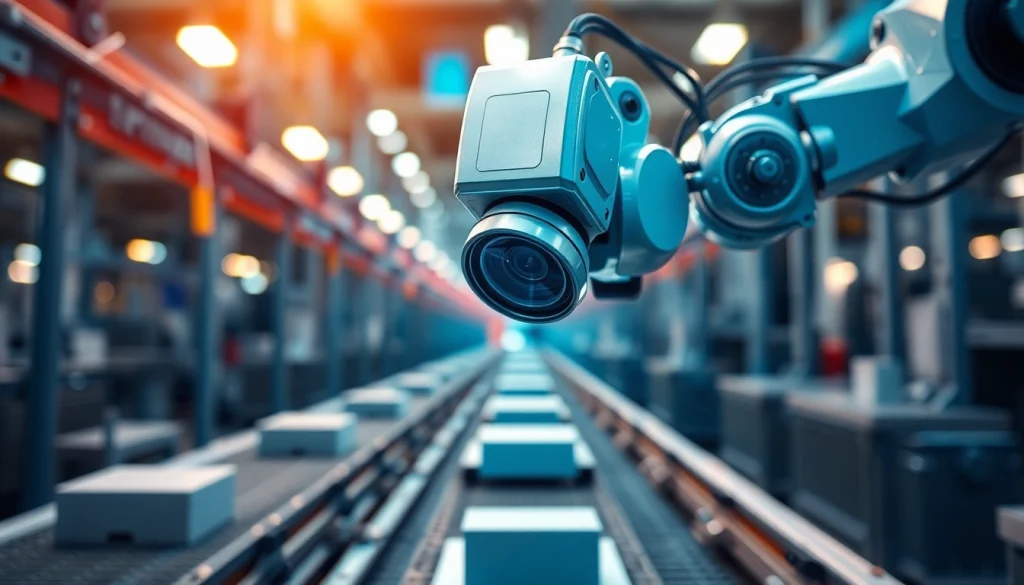What is Machine Vision?
Definition and Overview
Machine vision refers to the technologies and methods used for automatic inspection and analysis of visual information by computers. A primary function of machine vision is to enable machines to perform tasks that typically require human sight. This technology harnesses various tools including cameras, sensors, and advanced processing algorithms to replace or enhance human visual inspection processes. The driving force behind machine vision is the need for automation in industrial applications to improve efficiency, quality, and safety.
In an increasingly competitive market, companies are turning to machine vision to streamline operations and reduce costs associated with manual inspections. This technological evolution allows for systemic monitoring and analysis of products, ensuring defects are identified and rectified early in the manufacturing process, thus ensuring high standards of quality control.
Key Components of Machine Vision Systems
The effectiveness of machine vision systems hinges on several critical components:
- Cameras: These are the primary devices used to capture image data. They can be CCD (Charge-Coupled Device) or CMOS (Complementary Metal-Oxide-Semiconductor) based, catering to different operational needs.
- Lighting: Proper illumination is essential for capturing clear images. Various lighting techniques, such as backlighting, diffuse lighting, and ring lights, are used depending on the inspection requirements.
- Image Processing Software: After image capture, sophisticated algorithms analyze the data to extract meaningful information, handle filtering, edge detection, and pattern recognition.
- Output Devices: These can involve displays or alert systems that inform operators of the results of the analysis, indicating whether products meet the required standards or if there are failures.
How Machine Vision Works in Practice
Machine vision systems operate in a systematic manner. Initially, cameras capture images of the object or scene being inspected, driven by specific triggers such as motion or predefined schedules. The captured images are then processed in real-time or near real-time by the software—this may involve performing a series of operations such as:
- Image Acquisition: The camera captures continuous or sporadic visual data based on predefined conditions.
- Image Processing: This process includes filtering noise, enhancing contrast, and implementing other pre-processing techniques to prepare the image for inspection.
- Feature Extraction: Algorithms analyze the image to identify key features relevant to the inspection task, such as edges, shapes, or patterns.
- Decision Making: Based on the extracted data, the system makes a decision—be it classifying the object, determining quality, or invoking actions such as rejection or sorting.
Applications of Machine Vision in Industries
Quality Control and Defect Detection
Quality control is one of the most visible applications of machine vision. Many industries employ machine vision systems to detect defects in products during the manufacturing process. Unlike human operators, who may tire and overlook flaws, machine vision systems can consistently inspect thousands of units without fatigue.
For instance, in the automotive industry, machines can identify paint imperfections, alignment issues, or surface scratches almost instantaneously. In electronics manufacturing, machine vision can analyze the quality of solder joints on circuit boards, ensuring that each board meets stringent safety and performance standards.
Robotics and Automation Enhancements
Robotic systems equipped with machine vision have transformed the landscape of automation. These robots can not only perform physical work but also ‘see’, allowing them to interact intelligently with their environment. For example, in warehouses, robots use vision systems to identify and pick items accurately from shelves, reducing errors associated with logistics.
Furthermore, the integration of machine vision with AI enables predictive maintenance for robotic systems. The vision system can monitor components for wear or damage, signaling maintenance needs before failure occurs, thus ensuring operational efficiency.
Manufacturing Process Optimization
The application of machine vision extends beyond simple inspection. It is a vital component in process optimization. By analyzing visual data from multiple operations, machine vision systems can provide insights into entire production lines. This data can highlight bottlenecks, track cycle times, and enable continuous improvement.
Manufacturers employing machine vision for process analysis can implement adjustments for efficiency gains, optimize equipment usage, and ultimately reduce operational costs. Firms can look at historical data to guide future production plans based on visual insights.
Types of Machine Vision Systems
1D, 2D, and 3D Systems Explained
Machine vision systems can be categorized based on the dimensionality of the data they analyze:
- 1D Systems: These systems analyze linear data, usually employed in simple tasks such as barcode scanning or linear measurements.
- 2D Systems: Most common in industrial applications, 2D systems analyze flat images, perfect for surface inspection and pattern recognition.
- 3D Systems: These provide depth perception, allowing for the visualization of surfaces and volumes which is critical for applications like dimensional verification and robotic guidance.
Comparison of Different Imaging Technologies
In terms of imaging technology, common varieties include:
- Monochrome Imaging: Offers high contrast and is often used in quality control applications.
- Color Imaging: Useful for applications requiring color differentiation, such as identifying specific products based on color codes.
- Infrared Imaging: Effective for temperature measurements and certain security applications.
- Multispectral Imaging: Used in advanced analysis, particularly in fields like food safety and agricultural monitoring.
Choosing the Right Machine Vision System for Your Needs
Selecting the appropriate machine vision system involves evaluating several factors, including:
- Application Requirements: Understand the specific needs of the application, such as the required speed, resolution, and environment.
- Budget Limitations: Often, costs can vary significantly depending on system complexity and components used; prioritize crucial features over luxury options.
- Integration Needs: Ensure compatibility with existing equipment and software for seamless operation.
- Scalability: Choose systems that offer flexibility to grow with your production needs.
Machine Vision vs. Computer Vision
Defining the Differences
While related, machine vision and computer vision serve distinct purposes. Machine vision specifically focuses on industrial and automation applications aimed at improving process efficiency, automating inspection, and enhancing quality control. Conversely, computer vision is a broader field encompassing any technology that allows computers to interpret visual data, including facial recognition, video analysis, and more.
Applications of Each Technology
Machine vision finds its primary applications in manufacturing, packaging, quality inspection, and robotic guidance systems. In contrast, computer vision is utilized in self-driving cars, healthcare diagnostics, augmented reality, and security systems.
Potential for Integration Between Technologies
As industries continue to grow more adept at harnessing artificial intelligence, the potential for integrating machine vision and computer vision is significant. Projects might combine the real-time operational efficiency of machine vision with the analytical depth of computer vision, resulting in smarter automation solutions capable of adapting to varied tasks with unprecedented agility.
Future Trends in Machine Vision
Impact of AI and Deep Learning
The impact of artificial intelligence (AI) and deep learning on machine vision cannot be overstated. Machine learning algorithms are rapidly being integrated into vision systems, enabling them to become more accurate and adaptable over time. These intelligent systems can learn from previous inspections, improving their performance without the need for constant manual updates or recalibrations.
Emerging Technologies in Machine Vision
Recent advancements in sensor technology, computing power, and machine learning frameworks have ushered in new possibilities for machine vision. Notable trends include the development of smarter cameras that can perform preprocessing on images before transmitting them for further analysis, or the use of drones equipped with vision systems for monitoring large agricultural regions.
Market Growth and Industry Predictions
The machine vision market is poised for substantial growth in the coming years, driven by increased automation in manufacturing and the need for enhanced quality control across various sectors. According to market research, it is expected that adoption rates of machine vision systems will continue to rise, fueled by advancements in artificial intelligence and machine learning technologies.





